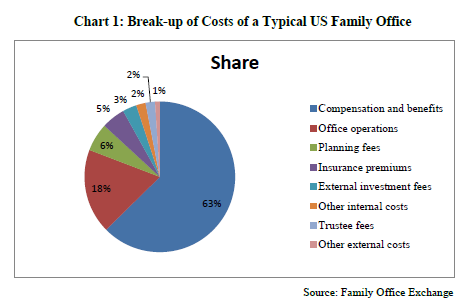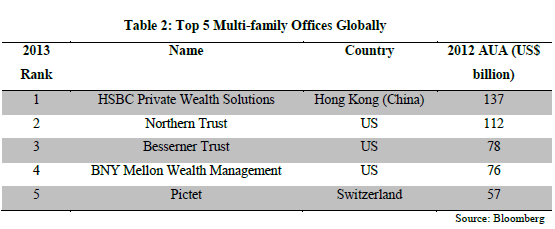Family Office

What Is It
It is a private advisory firm which caters primarily to the financial management needs of ultra-high net worth individuals (ultra HNIs) and families. There is no universally applicable definition for either ultra HNI or a family office. However, globally, the family offices have been open to include families or individual with net worth of at least US$50 million in their clientele base. Likewise, what functions do the family offices perform varies with family offices and the needs of their clients.
Typically, there are two types of family offices- single family offices and multi-family offices.
Single Family Offices:
Single family offices serve only one ultra-rich family. They have their operation and management customized towards the needs of their sole client. Many times, they have their offices set up within the residential or business premises of their client.Multi-family Offices:
Multi-family offices serve many ultra-HNI clients at the same time. They have a standardized operation and management procedure and common staff which are applied and deployed based upon the needs of the clients. They have their offices based in the locations where they can service more and more clients.
They may also be classified on the basis of the range of services they provide as- administrative family office, hybrid family office, and fully integrated family office.
Administrative Family Offices:
They employ staffs that provide bookkeeping, tax, and administrative services to the family.Hybrid Family Offices:
They provide administrative, legal, and administrative advice, but outsource non-strategic functions.Fully Integrated Family Offices:
They provide administrative, tax, legal advice, and core investment management services.
What Does It Do
Family offices are primarily to serve the investment management needs of their clients. But besides that, they perform myriad of other activities based upon and in agreement with the specific needs of the clients. Here is a comprehensive, but not exhaustive, list of the functions performed by them.
Portfolio Management & Investments:
This involves selection of proper fund manager, preparation and execution of investment plan and policy for the client, and managing investment risk and cash requirement.Tax Advisory:
The sectoral and geographical distribution of different types of assets and the complexity of the tax liabilities arising out of them need professional help for the ultra-HNIs. So, the tax advisory services provided by family offices are usually of great help to them.Reporting and Record Keeping:
This service involves organization of financial paperwork including compliance documents, investment details, insurance policies etc. It also helps the clients keeping track of the dates on which some event is coming or some important decision is required.Philanthropic Management:
It may involve establishment of proper organizational framework for charitable trusts and foundations, managing the investments ear-marked for them, and providing advisory assistance regarding useful distribution of the funds.Multigenerational Wealth Management:
The family offices help their ultra HNI clients in bequeathing their wealth to the future generations in a responsible and tax efficient manner in accordance with family traditions and values. It also helps in framing wills and other agreements related to inter-generational wealth transfer.Compliance and Regulatory Assistance:
It involves helping the clients to conform with the regional, national, and international legal and regulatory framework regarding their financial investments, trusts and foundations, movement of funds, acquisition and disposal of moving and non-moving assets etc.Risk Management & Insurance:
Some family offices recruit risk management and insurance experts in their teams to provide professional in-house advisory services to the clients, which is separate from the other wealth management services provided by them.Lifestyle Management & Budgeting:
Due to the hectic life schedule and frequent needs for visits, these clients need professional help to streamline their personal lives. This includes travel management assistance, domestic staff management, arrangements for parties and family unions, holiday scheduling and yacht arrangements, etc. While doing all these, they have also to make sure that their monthly budgets are in line with their current income and wealth and with the long-term wealth preservation goals.Training & Education:
In the era of evolving rules and regulations, new financial products and practices, and new possibilities for profitable investments, the family members need to be kept informed and educated so that they might judge the advices of their family offices more objectively. It might also help the younger generation having a more prudent approach towards earning, saving, investing, and wealth management.
Needless to say, all the services enlisted above are not necessarily provided by the all the family offices. That depends upon the needs of the client, cost structure of the services provided, the level of competition among the family offices at the place, and extant regulatory framework.
Cost Structure
Single family offices are unique to the families that set them up. So, the cost of running such institutions would depend on the size and level of competence of the employees they hire. Size may vary from 1-50, and the competence required would depend upon the complexity of the needs of the family. So, there can’t be an average cost level applicable to all the single family offices. Multi-family offices have their costs of services comparatively lower than those of single family offices. This is due to common employees, better networking with various service providers, and advantage of economies of scale.
Given the available evidence globally, a full-service family office would cost a minimum of US$1 million annually to run, and even more in many cases. So, for a family office to be viable, a family should be worth between US$100 million and US$500 million. Although, a family office may be set up with less than US$100 million in assets, though the services provided would be limited to administration, control of assets, consolidation, and risk management.
It has been found that they typically have operating costs between 30 basis points and 120 basis points of assets under advisement based upon the services provided by them. As per a study conducted by Capgemini in 2012, the overhead cost of maintaining a family office varied depending upon the assets under advisement and the type of family offices, i.e. the range of services they were providing. The following table shows the findings of that study.

A research from consultancy Family Office Exchange has found that more than 60% of total cost of a family office is allocated to staff compensation and benefits. The total break-up of cost of a typical US family office is shown below.

Indian Scenario
In India, traditionally family offices were the single family offices managing the private wealth of the big business families. After the liberalization of economy in early 1990s, the private wealth of many industrialists jumped many times, and thus increased the need for their prudent management. Many of them started their own single family offices to manage their family wealth. The prominent examples are Premji Invest of Mr. Azim Premji, Khimji family office of Mr. Ajit Khimji, Catamaran of Mr. N R Narayan Murthy, and the Ambani family. Besides these big names, many more ultra-affluent families arose out of the growth story of post-liberalization Indian economy with significant investable surplus. Responding to the needs of these families, many financial firms like private banks, non-banking financial institutions, asset management companies, brokerage firms etc. started their family office divisions to work as multi-family offices.
Like global scenario, In India also, there is no universally applicable definition of ultra-HNI and family offices. Also, they work in absolute confidentiality with their clients. So, the number of family offices can only be estimated. As per one estimate, the number of family offices in India in March, 2014 was around 200, and is expected to grow to around 500 over next 5 years. As per another estimate, the number of family offices in India is expected to reach 940 till 2015.
As per the latest World Ultra Wealth Report by Wealth-X, India is home to 7850 ultra-high net worth individuals who have more than US$30 million investable income each and a combined wealth of US$935 billion. The low penetration of family offices at just 20% and huge amount of inter-generational wealth transfers of about INR5.78 lakh crore i.e. about US$128 billion to take place in coming decade is providing the family offices opportunity to grow by leaps and bounds in India.
Many domestic private banks and foreign banks are into family office business in India. Prominent among them are BNY Mellon, BNP Paribas, Credit Suisse, DSP Merrill Lynch, Kotak Mahindra Bank, etc. However, there are a large number of boutique firms also with a market share of around 47%, like Altamount Capital, Client Associates, Waterfield Advisors, Credence etc. to name a few.
Global Scenario
Family offices have their roots in the sixth century, when a king’s steward was responsible for managing royal wealth. Later on, the aristocracy also called on this service from the steward, creating the concept of stewardship that still exists today. However, the modern concept of family office developed in the 19th century when the family of financier and art collector J P Morgan founded the House of Morgan to manage the family assets. In 1882, John D Rockefeller established an office of professionals to organize his complex business and financial operations and to manage his family’s growing investment needs.
The family office business is a secretive kind of business like hedge funds. The family offices typically do not reveal the assets under advisement and other details of their clients. So, it is difficult to estimate the exact figure of global assets under advisement of the family offices. Also, estimate of the number of the family offices vary due to different parameters being used to define family offices by different firms.
By one estimate of Family Offices Group, there are more than 3000 family offices in US with another 1000 in Europe and even more in Asia, Latin America and other areas of world. As per another estimate, in US alone, there are estimated 4000 family offices, with over UD$1 trillion in assets under advisement. As per a Cap Gemini report, the number of family offices in US has grown to about 3000 single family offices with asset under management between US$1.0-1.2 trillion. Also, there are about 150 multi-family offices having assets under management between US$400-450 billion.
In June, 2014, Bloomberg published a ranking of top 50 multi-family offices based on the assets under advisement as of December 31st, 2012 from among the 118 firms globally which responded to its request for information. The top 5 of them with their country and assets under advisement are given below.

Challenges Ahead
- Family offices worldwide are largely unregulated or relatively very less regulated. Future regulatory reforms might need them to bring transparency in their operations and reporting. This might hit their confidentiality characteristic which drives the urge of ultra HNIs to hire them. They may also be needed to restructure their operations, as has happened in US in aftermath of the Dodd-Frank Act.
- With increasing competition among family offices to garner higher market share, it is necessary to remain cost-efficient. Even the single family offices need to achieve and maintain cost efficiency to generate higher total returns on assets under advisement. For that, the cost of operations, staffing, and running IT systems etc. need to be curbed. Also, as the family offices are accepting clients with smaller and smaller net worth, the advantage of economies of scale would also be waning.
- With increasing competition from investment advisory, asset management, hedge funds etc., it is becoming increasingly harder for the family offices to hire and retain suitable talent.
- With increasing re-location of family members at different foreign locations, the family office functions are becoming more and more complex due to cross-border transactions involving different legal and tax jurisdictions. This is also forcing them hire personnel in more than one country.
- With increasing regulatory oversight over the financial markets, they may have to invest in new IT architecture to comply with emerging reporting and risk management requirement. This might involve substantial costs.
- Increasing investments in alternative asset classes like real estate, commodities, timberland, agriculture, private equities etc. will increase the complexity for tracking and reporting those investments.
- With increasing competition among the family offices for family assets, the return to be generated is also going to be an increasingly important besides preservation of wealth. As per a study of UBS and Campden Wealth Research conducted this year on 205 family offices with on average US$890 million in asset under management distributed over 40 countries in 6 continents, and managing total of US$180 billion in private wealth, the average family office investment portfolio returned an estimated 9% in 2013.
Conclusion
Growing economic prosperity, huge investable surplus and need for intergenerational transfer of wealth will further boost the demand for family offices. However, increasing competition, regulatory intervention, cost inefficiency, complexity of operations, shortage of talents etc. are the immediate challenges which they are facing currently. In this situation, they need to re-visit their operational structure and wealth management processes, and either weed out the inefficient ones or re-structure them.
Possible solutions could be: partnership of single family offices with multi-family ones, upgradation of risk analytics and portfolio management tools, out-sourcing non-core functions, searching for new investment asset classes etc. A self-regulatory body comprising all family offices and mandated with setting uniform standards and practices consistent with the various regulatory requirements would be of great help to bring transparency and credibility to them.
Disclaimer:
This communication is only meant for qualified and certified Financial Advisors. This document should not be construed as an invitation/recommendation to purchase or sell a security or take any position in the market. While Pulse Labs has taken every care to ensure that the information/data is accurate and complete, we do not take any responsibility for any errors and omissions.Queries
-
What is the benefit of mutual fund STP
Aug 29, 2019
-
How much to invest to meet target amount of Rs 2 Crores
Aug 26, 2019
-
Can I achieve my financial goals with my current mutual fund investments
Aug 24, 2019
-
Can you tell me return of various indices
Aug 19, 2019
-
What would be the post tax return on different investments
Aug 18, 2019
-
Which Principal Mutual Fund scheme will be suitable for my retirement corpus
Aug 16, 2019
-
What is the minimum holding period for availing NCD interest
Aug 4, 2019
Top Performing Mutual Funds
Recommended Reading
Fund News
-
Zerodha Mutual Fund launches Zerodha Nifty Short Duration G Sec Index Fund
Dec 26, 2025 by Advisorkhoj Team
-
Groww Mutual Fund launches Groww Nifty Chemicals ETF
Dec 26, 2025 by Advisorkhoj Team
-
DSP Mutual Fund launches DSP Nifty Next 50 ETF
Dec 19, 2025 by Advisorkhoj Team
-
DSP Mutual Fund launches DSP Nifty 500 Index Fund
Dec 19, 2025 by Advisorkhoj Team
-
Kotak Mahindra Mutual Fund launches Kotak Nifty Next 50 ETF
Dec 18, 2025 by Advisorkhoj Team














